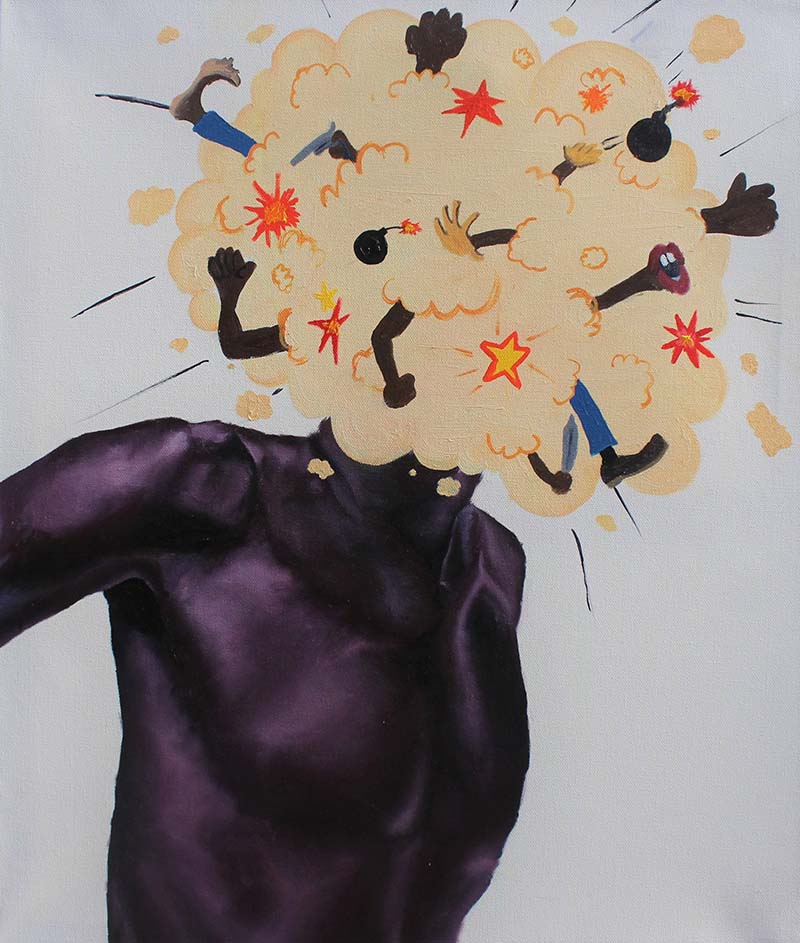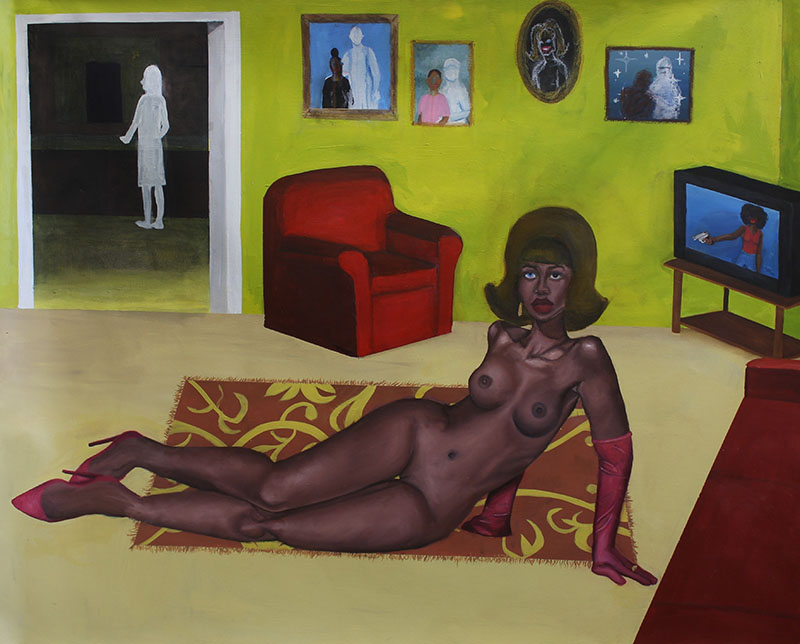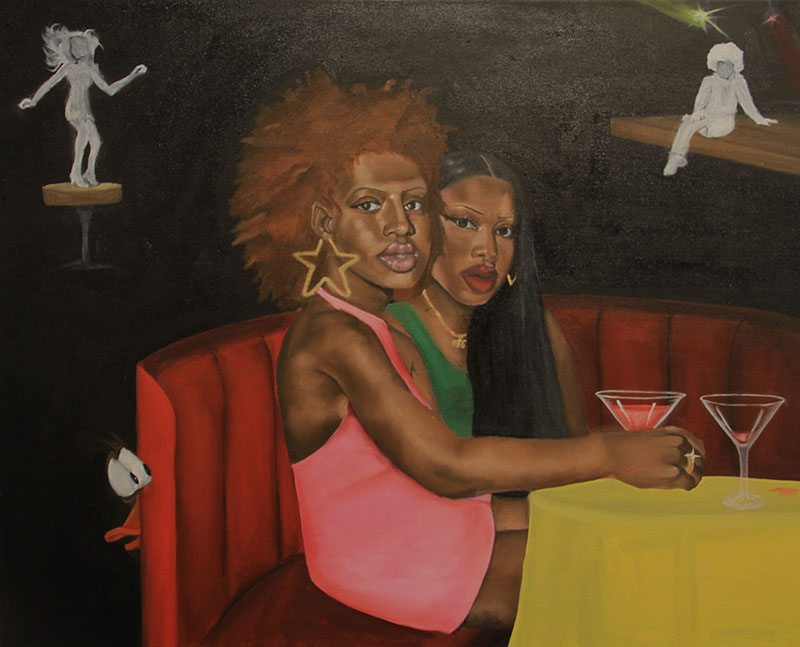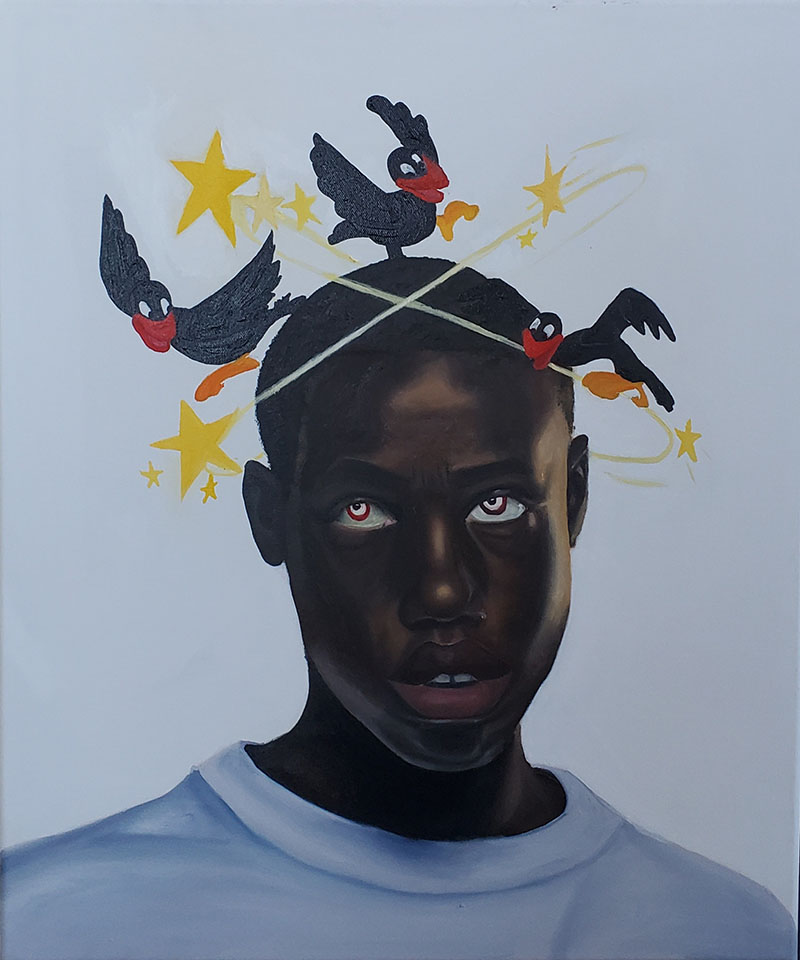Alumna Kaleigh Blevins Explores Interiority in Black Experience
 Kaleigh Blevins (BFA ’22), who studied Painting with a minor in Graphic Design, is beginning to be recognized internationally as an emerging painter. In August 2022, three of her pieces were selected for the prestigious publication New American Paintings, Midwest Issue #161. She is currently preparing for an upcoming two-person exhibition with Cailyn Dawson at M Contemporary Art in Ferndale, MI., opening June 2023.
Kaleigh Blevins (BFA ’22), who studied Painting with a minor in Graphic Design, is beginning to be recognized internationally as an emerging painter. In August 2022, three of her pieces were selected for the prestigious publication New American Paintings, Midwest Issue #161. She is currently preparing for an upcoming two-person exhibition with Cailyn Dawson at M Contemporary Art in Ferndale, MI., opening June 2023.
Blevins’ work “explores the uncertainty of life through a Black lens” and “highlights how absurd the world can feel for Black Americans.” She does this by portraying environments that traditionally feel familiar and safe, but come across as distorted through scarcely filled interiors and imposed imagery from pop culture. These elements create a feeling of “uncomfortable intimacy” between the subject and the viewer. She draws inspiration from artists Arcmanoro Niles, Richard Mayhew, Jennifer Packer, Mickalene Thomas, Kerry James Marshall, and Barkley Hendricks. “These are artists — especially Hendricks — who are interested in the grounded nature of the Black figure, and in making Blacks look realized and human and beautiful.”
Challenging the Excellence Push
Blevins attended Cass Technical High School, where she concentrated on Commercial Art. Cass Tech is a predominantly Black high school with a renowned reputation for graduating successful creatives. It was there that she connected with painting teacher, Carole Morisseau, who took a serious interest in her and helped her build a portfolio. “Carole Morisseau held a few of us to a higher standard,” she says. “I didn’t appreciate that at the time, but I actually really appreciate it now.”
At Cass Tech, she also began to realize a tension in the Black American experience related to notions of achievement. She says, “Diana Ross graduated from Cass; Big Sean, Kwame Kilpatrick [too]. There is this push for excellence that creates extremes for Black people in terms of representation. This really means you are seen as being either destined for failure or destined for excellence. That is a narrow view and a generalization.” This belief also stems from Blevins’ interest in mythology, specifically the story of Icarus. “Nobody wants to be like Icarus,” she says. “You fly too close to the sun, and you drown and you fail.”
While Blevins acknowledges her own success, she doesn’t want labels for herself. “People might say that I’m a symbol of excellence but I'm just me. I'm just living,” she says. “I want to do things to the best of my ability. I don't need to be seen as excellent. I want people to like my work, but I don’t want the pressure to crush my creativity. We have a lot of heroes in popular culture and the most successful Black people are supposed to be our Saviors. But I don't think of it like that.”

Blevins wants an expanded representation of the Black experience and Black subjectivity, beyond one image or one type of identity. She adds that, “Good representation of Black people can be empty. You get fantastical portraits or something like that, plantation narratives and slave narratives. I really want to think about interiority — the quality of being for a person. I want to think about Black people just existing as people and what that experience is all about.”
Painting the Interior
When Blevins started at WSU, she was nervous about failing. She quickly learned that she thrived in the structure of the educational environment and with the regular critiques from her instructors. However, it was during the Covid-19 pandemic lockdown that she reached a pivotal moment with the subject matter of her work and what she wanted to say. She says, “I remember that we had our last critique and were on a spring break. I had just reached this point with the work where I felt like I was onto something conceptually. I had always been interested in figures, and I wanted to do something weird. I wasn’t trying to make work about different social issues or politics, because I don’t think that I am solving problems with my paintings. But I do want my work to open up more conversations about identity and about Blackness and really about Black people in America. The experience is kind of surreal. You live as a person, and you don’t exist in the vacuum, but it is when you have these outside interactions that you understand what it really means to be Black.”

Blevins explores the tensions between the comfort and privacy of home and the voyeuristic gaze that can feel omnipresent. She describes, “I paint a lot of these interior spaces because the home space is supposed to be the safest for you and the most familiar to you. When you’re at home, you’re supposed to act naturally. But in these paintings, the viewer is in a voyeuristic position to ask the question, ‘What if you had this invisible audience?’ Then, even when you were at home, your home [would] become an unfamiliar place to you. Everything is then unfamiliar, everything’s off and kind of wrong.”
Blevins’ breakthrough painting in expressing these ideas was her 2022 work, Under Watchful Eyes. In it, a Black woman reclines in a Venus pose in a sparsely furnished living room. The woman is naked except for gloves, heels, and a ring. Her hair is styled in a 1960s bob. In the background is a white figure against a dark room, which is a marker of a presence that might be felt, Blevins explains. The white figure is an element that she uses in other paintings. She says, “I don't think of them as the representations of people, but more of a conflict of not feeling natural in the position that they are in and what they are doing, knowing that they have to perform.” There is a TV set showing a Black girl aiming a gun, her Afro covering her face except for her lips, which is meant to convey another stereotype of Black women found in Black Exploitation films. The gun on the screen seems to be pointed at the woman on the floor. “I wanted to drive home that sense of emptiness and absence in the settings where these figures perform. There is nothing but the ideas that they are holding onto.”

In the painting entitled Youngblood, there's a young man flexing a bicep in the middle of an empty room. “I was thinking a lot about the hyper masculine ideal for Black men specifically, and the kind of place that this guy might be in. I imagine the sound of white or pink noise. His body is small, he’s not very strong. His expression is not convincing. It’s this combination of performance and vulnerability, and the vulnerability is in him performing the act of this idea of masculinity.”
Another painting Act Natural shows two women in a booth at a nightclub. Blevins wanted to convey the sense that the subjects were interrupted by the viewer, their expressions look as if they have been interrupted or just approached by an odd presence. “I want to convey the idea that you don't get free reign to look at them. You are under surveillance in the same way as they are. Most of the environment they are in is concealed, which is also a way to disarm the viewer.”

Blevins often uses popular cartoon characters to disarm the viewer and create tension, and in this painting, she incorporates a representation of Daffy Duck. She explains, “I have always had this interest in animation and cartoons, because they don't have to stick to the laws of realism, and because cartoons are cute and funny sometimes, but also a way to spread information, ideas, and often racist stereotypes. I am dipping my toe into mixing these different planes and realities together. I think that’s the main function of my work — to bring together different realities.” She included a cartoon-like smiling angel in an otherwise very serious self-portrait to have a similar impact. “It's more of a serious setting, and this little angel is happy. It's kind of stupid, but that's the point,” she says. “It's like an odd moment of levity that makes it strange. We’re supposed to laugh.”

WSU Experience and Beyond
Blevins enrolled in WSU with a clear idea of what she wanted to do, the classes that she wanted to take, and the instructors whom which she wanted to work. The instructors were generous and focused on her success, she says, calling particular attention to her painting instructor Adrian Hatfield. “I feel like when you seem serious, they see that in you, and they will pour into you. Adrian Hatfield is great. He’s an amazing artist, and during my time, he gave me the tools to get to where I was doing, even if I wasn’t sure where I was going. I've gained a lot from my art classes, and also Art History and Literature classes.”
At the moment, Blevins is appreciating the recognition she is receiving for her work, being able to show in local galleries and be included in New American Paintings. “It is great to be validated by the artists that are farther ahead of me. When they say, ‘I really like your work, and I think you’re going to be everywhere,’ that level of respect is really important to me.”
Blevins plans to attend graduate school but is currently taking a gap year to focus on making more work and putting together a solo show. She reiterates, “In the school environment, you have the tools to direct you where you need to go, the environment and good faculty, the peers that you may gain that can show you different perspectives. I definitely think it was good for me to wait out this one year, but I also want to be moving forward into the next step.”
Links:
https://www.newamericanpaintings.com/artists/kaleigh-blevins
https://www.mcontemporaryart.com/